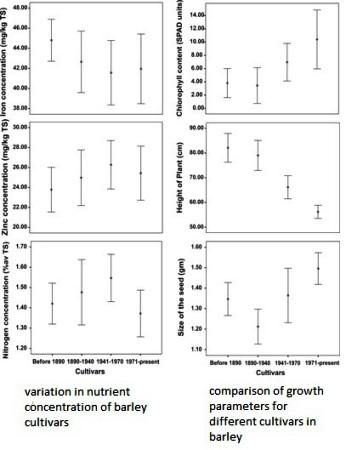comparison of growth parameters among the different cultivars
The barley lines were classified into four groups based on the different time periods and each group contains twenty different barley accessions. chlorophyll content, plant height and seed size were measured for the different barley varieties and compared among the four different groups using ANOVA. The results show a decreasing trend in the height of the plant from the landraces to the present cultivars. The kernel size show an increasing trend in the seed size from cultivars (before 1890) to the present crops. The chlorophyll content has increased from cultivars before 1890 to the modern cultivars (1971-present)(as shown in figure below right).

Determination of grain protein and mineral concentratin in barley
Seeds from the 82 barley varieties were harvested and used to measure the seed size, as well as the contents of N, Fe and Zn. Interestingly, there were no significant variation in the N, Fe, or Zn content among the barley accessions when grouped after time period of origin or geographical origin of the cultivars(shown in above figure left). When two row and six row cultivars were compared, we found that N and Zn were significantly higher in two row varieties, whereas the Fe content was found to be higher in six row cultivars. Interestingly, the single Swedish two row barley accession from 1890-1940 had highest content of N, Fe and Zn of all 82 accessions(fig not shown).
Responsible for this page:
Director of undergraduate studies Biology
Last updated:
05/20/11
